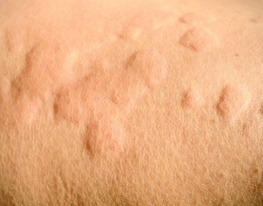About Us

Urticaria/hives
Urticaria, “wheals” or nettle-hives are pale red swellings of the skin that occur in groups or any part of the skin. Each hives lasts for a few minutes, hours, rarely up to a day, before gradually fading away without a trace. New hives may develop as old ones fade.
Some may appear as reddish raised streaks over the area where the nails have scratched. Hives are itchy, but may also burn and sting. During an acute episode, it is common for the patient to experience flushing, weakness, headaches, nausea, dizziness and tremors as well.
Hives are caused by tiny amounts of fluid that leaks from the blood vessels just under the skin surface. In some cases a condition called Angioedema develops. The swelling of Angioedema can occur anywhere in the body but most commonly affects the eyelids, lips and genitals.
Sometimes the tongue and throat are affected and become swollen. The swelling sometimes becomes bad enough to cause difficulty in breathing. Symptoms of Angioedema tend to last longer than urticarial wheals.
It may take up to three days for the swelling of the lips to subside and go. Angioedema may not always be itchy, and may or may not be associated with hives. Angioedema is a medical emergency and has to be treated with antihistamines, adrenaline or steroid injections.
Hives and Angioedema are caused by the release of a chemical called Histamine. Allergic reactions, chemicals in food, or certain medications notably pain-killers can cause histamine release. Sometimes no cause may be identified.
Hives are very common. 10-20% of the population will have at least one episode in their lifetime. Hives of less than 6 weeks duration are called Acute Urticaria. With this type of hives, the cause can usually be found, eg food, medications, insect bites, infections etc.
Hives which occur on a daily basis for more than 6 weeks are called Chronic Urticaria. It is twice as common in women. The cause of this type of urticaria is usually harder to isolate.
Your dermatologist will need to ask several questions and perform several tests in an attempt to find the possible cause. In up to a third of cases, the cause may be an ‘auto-immune’ problem. Auto-immune means that the body’s antibodies cause disease.
Antibodies normally fight off germs (viruses and bacteria). In some people, one type of antibody attaches to cells under the skin and causes them to release histamine and other chemicals. The reason why this happens is not clear. Chronic urticaria may last for several years. In about half the cases, symptoms disappear within 3-5 years.
Foods that Cause Urticaria
The most common culprits are fish, meat, eggs, chocolates, soya, nuts and milk. Food additives and preservatives may also cause hives. These hives appear within minutes or within an hour of a meal.
Medications that Cause Urticaria
Are mostly pain-killers, antibiotics and sedatives. Vaccines, toxins, injectable dyes and insect bites are also included in this category. If you have an attack of hives, it is important to tell your doctor about all the medications you use (Allopathic or alternative).
Infections that Cause Urticaria
Common cold and stomach infections are the commonest causes. If you have a chronic tonsil or ear infection, if you suffer from stomach acidity, recurrent urinary tract infections or intestinal worms, these infections can also be responsible for your hives.
Medical Conditions that Cause Urticaria
Thyroid disorders and Lupus are most commonly associated.
Physical Urticaria
Hives can be caused by sunlight, heat, cold, pressure, vibration or exercise. These can be easily diagnosed with a ‘challenge’ test, which should only be performed under a doctor’s supervision.
Dermographic Urticaria
Hives that form after firmly stroking or scratching the skin are called ‘dermographism’ or ‘symptomatic urticaria’. It affects about 5% of the population.
Atopics
Atopic patients are prone to all kind of allergies – Skin allergies like Eczema and insect bite sensitivity. They may also have concurrent eye, respiratory, food or drug allergies. Atopics are more likely to experience episodes of Urticaria, in their lifetime. Hives can also be triggered by insect bites (bees, spiders etc)
Angiodema and Urticarial Vasculitis
When hives last for over 24 hours, are painful to touch, fade away with skin staining, and/or accompanied by fever, joint pains, abdominal cramping or dark colored urine, this is a severe form of Urticaria called Vasculitis. It may require an immediate skin biopsy, investigations and aggressive medication.
Angiodema, as discussed earlier, requires urgent medical attention as well.
Management
The best treatment is to find the cause and eliminate it from your surroundings. This is not always easy, and is sometimes just impossible. For hives that last over 6 weeks, and the patient has not been able to recognize any pattern or trigger; a battery of investigations may identify the cause. It IS possible that all your investigations may come back normal. This is Chronic Spontaneous (or) Idiopathic Urticaria, for which a patient may need to be on anti-allergy medications for several months or few years. The medications provide symptom-relief, until your body recovers in its own time.
Antihistamines are usually prescribed by your doctor to provide relief. Antihistamines work best if taken on a regular schedule. The newer antihistamines do not cause drowsiness or tolerance after prolonged use. No one antihistamine works best for everyone, so your dermatologist may have to try more than one, or different combinations to find out what works best for you. The idea is to find the “minimum effective dose”, which is one pill that can keep you hives-free for at least 24 hours. In severe cases of Urticaria, patients may have to take 3-4 pills of various antihistamines, to keep their hives and itching under control. In Chronic Urticaria, the medications can be gradually reduced over time. Some patients need to take only 1 pill every 48-96 hours, to keep their symptoms in control.
Severe cases have to be treated with a short course of oral steroids.

